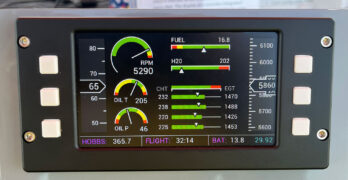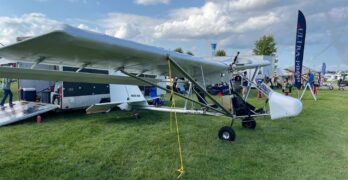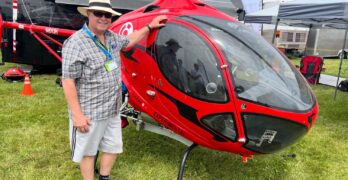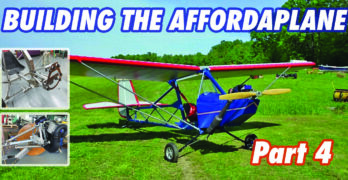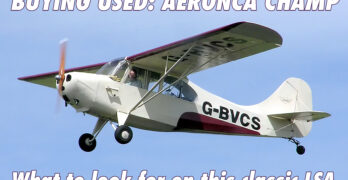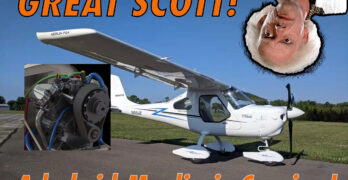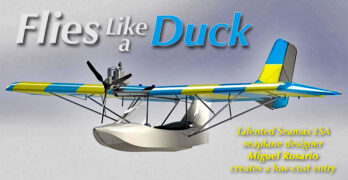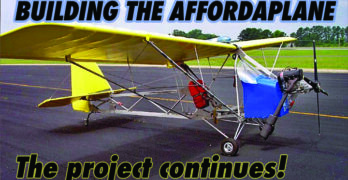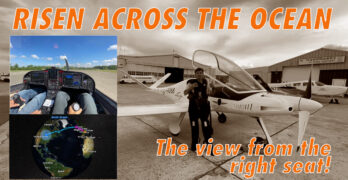If you are piloting an ultralight or light plane VFR, you really don’t need an artificial horizon or a heading indicator. But you do need airspeed and altitude, and it’d be nice to have that available in a compact, clear, modern package. Even better, you’d like to make sure everything is happy in the power barn, as well as your airspeed and altitude.
In the spirit of providing everything you need and nothing you don’t, Wapsi Aero brought a bright and affordable electronic flight instrument that has generated quite a bit of buzz at AirVenture’s ultralight field. The rectangular instrument provides graphical engine data mid screen with airspeed and altitude in legible tape readouts on each side—combining a partial EFIS with an engine monitor. The screen is bright and easily readable, even in direct sunlight. The instrument also provides Hobbs and flight timers as well as battery voltage.
Even better, the Wapsi device is designed to fit into the same hole that may currently house a GRT EIS engine monitor—of which there have to be thousands in the field.
Search Results for : Flight Design
Not finding exactly what you expected? Try our advanced search option.
Select a manufacturer to go straight to all our content about that manufacturer.
Select an aircraft model to go straight to all our content about that model.
Dragonfly Rancher Gets New Life in Florida
There is a two place tandem high wing light plane that looks a little like a single engine AirCam that has been knocking around for over a decade in, of all places, the hang gliding community. This sturdy craft, the Dragonfly Rancher, has been used to tow hang gliders to altitude without the necessity of plunging off a cliff. Developed by Bobby Bailey in the 80s, the Dragonfly earned its position as the premier hang glider tower when Bill Moyes invented a reliable and effective release mechanism for towing use.
The Dragonfly Rancher has also been put to agricultural use, as a ranch surveyor and even a spot sprayer. This workhorse has had almost a cult following, with many pilots taking advantage of its beefy construction to perform impressive aerobatics on YouTube. It is designed to take +6 to -2 Gs.
The Dragonfly Rancher design was owned by Pittman Air, LLC.
Cicaré 8 Kit Helicopter Debuts at AirVenture
It is hard to miss the sexy, sleek, Ferrari-red two-place helicopter on the Ultralight field at AirVenture. It’s new, it’s beautiful, and, as it turns out, it is a kit which can be completed in 200 hours, or even faster at a Cicaré builder assist facility. The two-place Cicaré 8 helicopter is appearing at AirVenture for the first time, made possible by Keith Barr, the President and CEO of the newly formed Cicaré USA corporation.
If the Cicaré name rings a bell, it is because of Augusto Cicaré, who moved from Italy to Argentina at age 19 to start and build what is now the storied Cicaré Helicopter Company. Cicaré has been designing and building helicopters for the Argentinian civilian and military since the early 1960s. Although Augusto died in January of 2022, his sons have continued the business, with great success.
The two place side by side Cicaré 8 was designed in Argentina in 2015.
Building the Affordaplane, Part 4
With this, the last chapter of the Affordaplane build, I will describe how an engine mount was created to complete the last major step. As a quick recap of the previous chapters in this series, I was attempting to plans build a legal ultralight using common tools and store-purchased materials. For example: No welding allowed! So, now the biggest challenge confronting me was creating an engine mount needed for the engine installation.
First, what engine should be used in this project? This decision could not be made until we were nearly finished with the entire project. Why? The choice of engine is determined by how much weight remains after deducting the aircraft’s total weight from the 254-pound limit imposed by the FAA ultralight regulations. With the wings and tail attached to the fuselage, I weighed the entire structure. Without an engine, the scales read very close to 200 pounds.
Buying Used: Aeronca Champ—A Plane That Deserves Your Respect
The Aeronca Champion might be the Rodney Dangerfield of light aircraft. The plane, which has historically played second fiddle to the Piper Cub, doesn’t get the respect it deserves, according to its fans. “Take all the light planes from that era and look at which offers the best characteristics… I would place the Champ at the top,” argues John Weigel, a Boston area pilot who twice flew a Champ from coast to coast. “I love the Cub,” he says, “but the Champ has no bad qualities. And if I’m taking someone up with me, I’ll take it over other similar planes every time.”
When compared to the Cub, as well as the Luscombe, Taylorcraft and Cessna 120 and 140, among other tailwheelers, the Champ is easier to get into, offers more comfort, has better visibility, more forgiving landing gear and is probably the better training/low-time pilot aircraft. All are good reasons to consider a Champ if you’re looking for a simple, relatively inexpensive and fun to fly aircraft.
Look Out — A Hybrid Merlin is Coming!
First introduced in Europe in 2013, the all aluminum single seat enclosed cabin Merlin LSA has sported a variety of engines, including a Rotax 582, a specially built four stroke V-twin and even an electric motor. In fact, the Merlin airframe has served as a test bed for all kinds of propulsion and aerodynamic innovations. At AirVenture 2023, Aeromarine chief designer Chip Erwin even showcased a Merlin model with twin propellors imbedded in the wings. Erwin promises an even bigger surprise at Oshkosh later this month: a common-sense hybrid propulsion system for the Merlin.
Erwin, who has done work for the Air Force Research Lab in Dayton, Ohio, has developed a parallel hybrid drive system for light sport aircraft that utilizes an electric motor to add to thrust generated by a
piston engine during takeoff and climb, but shuts down during cruise. He points out that a major limitation of all electric aircraft is the need to lug around a heavy battery capable of providing thrust for a limited period of time.
If It Flies Like a Duck and Floats Like a Duck, Maybe It IS a Duck
Article Updated July 17, 2024 — After this article was posted, Miguel Rosario reported, “Duck is still in tests. Now we will install a 912 ULS 80-horsepower engine, as requested by future customers.” He continued, “Molds are under construction for production, which we hope to start in three months” (approximately October 1, 2024). He finished, “I will keep you updated on all developments regarding Duck.” —DJ
You probably know Seamax. This longtime, performance-oriented LSA seaplane was one of the first to make a splash in the U.S. light aircraft market way back in December, 2007.
Today, regretfully, the Seamax company is going through some very difficult circumstances as noted in this State of the Seaplane Sector report. We don’t know the end of those stories yet.
Nonetheless, Seamax M-22 designer Miguel Rosario remains active. You can’t keep a good man down but apparently you can keep him on the water.
Building the Affordaplane, Part 3
In the previous installment, I described construction details for the fuselage section of the Affordaplane ultralight project. Now let’s look at construction of the empennage and wing assemblies. Remember, this is a plans-only type of build using off-the-shelf materials and tools intended for a novice builder. Keep this objective in mind when reviewing the construction and design details. A complete free video series on YouTube shows each step of this construction.
The components of the empennage (rudder, elevator, vertical and horizontal stabilizers) are all formed from 1-inch 6061-T6 aluminum tubing. These tubes must be bent into their respective shapes, matching template patterns drawn on your workbench. (Use some craft paper for this!) What is the easiest way to form these simple bends? I found that using an electrician’s conduit bender did the job nicely. With a little practice, each tube was formed to the proper shape and then fitted with a gusset to join its ends.
Inside the Transatlantic Crossing of the Risen
We recently reported that the newest version of the sleek, retractable-gear Risen had made a successful transatlantic crossing. From what we could piece together from outside accounts and posts on social media, it went well. But here’s a more first-person look at the crossing, from the perspective of the right seat.
Andrea Venturini accompanied designer Alberto Porto on the epic journey across the pond. Here’s his account.
It all started last December, with a phone call I received from Alberto Porto. At the time, I was in Australia doing a report at the Gliding World Championship for theItalianTeam. Onthephone Alberto, designer and builder of the fastest ultralight in the world (430 kph/232 knots), with the simplicity that always distinguishes him, says: ”Andrea, keep yourself free for next June, I’ll detail everything when you return to Italy.”
You can imagine my curiosity in the meantime. A few weeks later, the mystery was revealed: the Risen Superveloce with the brand new Rotax 916 iS must be brought to Oshkosh, to AirVenture, the largest and the most important aviation fair ‘of the Universe.’ I knew well what Oshkosh meant.
Advanced Degree in Rotax-erie
Editor’s Note: This story originally appeared in KITPLANES magazine but since so much of the LSA world depends on Rotax engines, we thought this was worth a read here.
Thirteen years into my two-year SeaRey build, OspRey finally had its engine mounted. But when I signed on the dotted line for my new Rotax 914, and with little more knowledge than how to change the oil in my car, I was nervous about my abilities to maintain this expensive engine. Because of this, back in 2014, I attended a weeklong service and maintenance class at Canadian Rotax distributor Rotech Motor, Ltd. Thanks to an excellent hands-on instructor, who acted like he had all the time in the world and a bagful of instructor tricks to teach us, by the second afternoon I had dropped my skepticism and distrust of the price/power ratio of the Rotax engine and was (almost) ready to go out and get a Rotax tattoo.
- « Previous Page
- 1
- …
- 43
- 44
- 45
- 46
- 47
- …
- 148
- Next Page »


